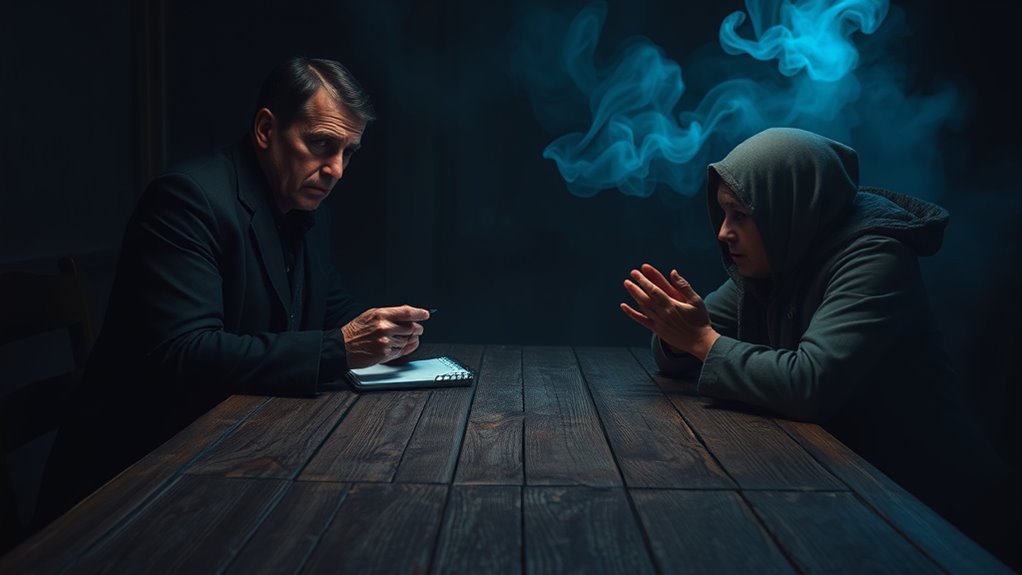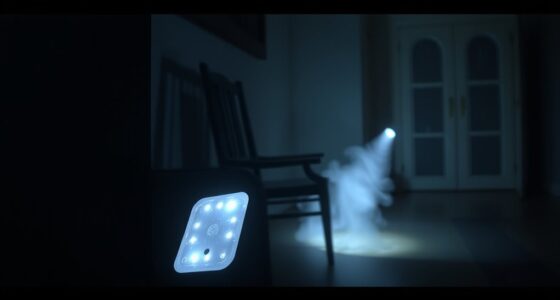When interviewing a ghost witness, start by building trust through empathetic listening and creating a safe, private space. Ask open-ended questions to encourage detailed responses, paying close attention to their body language and tone. Stay patient and respectful, especially if they show distress or hesitation. Record their words accurately and be mindful of cultural differences. If you want to learn more about gathering credible eyewitness accounts, continue exploring essential techniques and ethical considerations.
Key Takeaways
- Build rapport with empathy and patience, creating a safe, private environment to encourage open sharing.
- Use open-ended questions and attentive listening to elicit detailed, nuanced eyewitness descriptions.
- Observe non-verbal cues like facial expressions and body language to gauge emotional states and credibility.
- Clarify details gently, verifying location, time, and environmental conditions to ensure accurate documentation.
- Handle sensitive information ethically, offering reassurance and respecting emotional boundaries during the interview.
Preparing for the Interview

Before conducting an interview with a ghost eyewitness, it’s essential to prepare thoroughly. Understanding the historical context of the location helps you ask relevant questions and interpret the witness’s account accurately. Research past events, notable figures, or incidents associated with the site to deepen your perspective. Additionally, consider legal considerations—know local laws about recording conversations or interviewing on private property to avoid legal issues. Clarify whether you need permission or waivers, especially if the location is private or protected. Preparing these aspects in advance ensures you approach the interview professionally and ethically. Being well-informed about the history and legalities will help you focus on gathering authentic eyewitness accounts without unnecessary complications. Familiarizing yourself with security camera maintenance can also provide insights into how evidence might be preserved or reviewed. Moreover, understanding astrological compatibility can sometimes offer unexpected insights into personal perceptions and biases during the interview process. Additionally, having a basic knowledge of vetted global world concepts can help you recognize potential cultural influences on witness testimonies. Being aware of privacy and cookie usage principles can help you manage confidential information shared during the interview process. Furthermore, understanding sound healing science might assist in creating a calming environment that encourages open communication.
Establishing Rapport and Trust
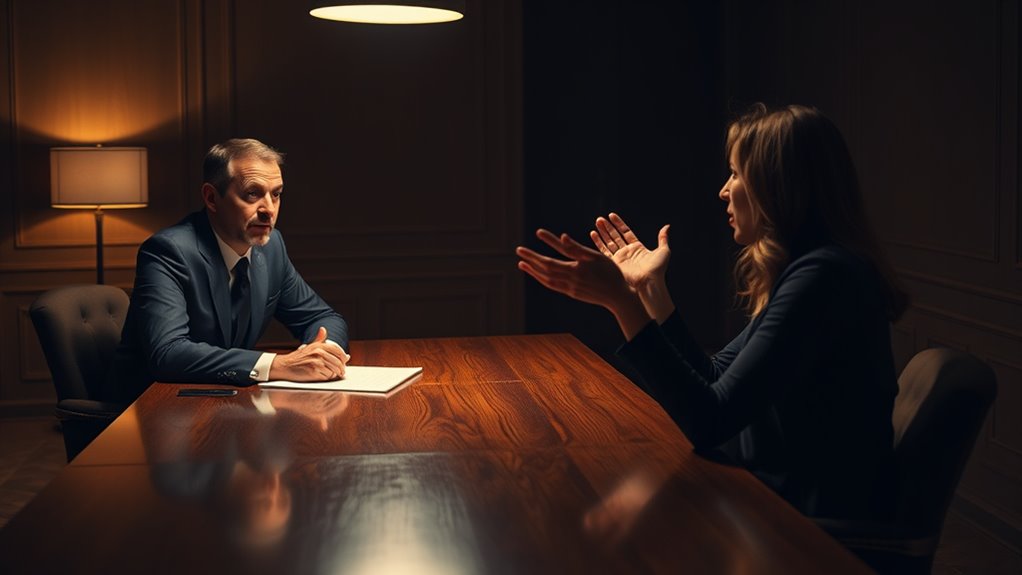
Building rapport and trust with a ghost eyewitness is essential for obtaining honest and detailed accounts. Start by approaching the interview with empathy and patience, showing genuine interest in their story. Use open-ended questions to encourage them to share freely, and listen carefully without interrupting. Establishing trust means respecting their perspective, even if their experiences seem unusual. Avoid rushing or appearing skeptical, as this might shut down communication. Your calm demeanor and attentive attitude help create a safe space where they feel comfortable revealing their memories. Remember, building rapport isn’t just about asking questions; it’s about demonstrating you value their story and are committed to understanding their experience. This foundation makes it more likely you’ll gather accurate, meaningful insights. Recognizing the importance of building rapport can significantly improve the quality of the information you receive. Additionally, understanding the significance of trust-building techniques can foster a more open and honest dialogue with witnesses. Incorporating an understanding of projector technology and its impact on image clarity can also help in visualizing and interpreting any visual evidence they might describe. Being aware of communication strategies can further enhance your ability to connect with witnesses and obtain comprehensive accounts. Furthermore, employing active listening techniques can help witnesses feel truly heard and understood, strengthening the trust between both parties.
Creating a Comfortable Environment

Creating a comfortable environment is essential for encouraging open and honest ghost eyewitness accounts. Your choice of interview location plays a crucial role—opt for a quiet, private space where the witness feels safe and relaxed. Be mindful of cultural sensitivity by respecting their beliefs and background, avoiding any language or behaviors that might cause discomfort or mistrust. Sit at eye level and maintain a non-threatening posture to foster a sense of equality and ease. Keep the atmosphere calm and free from distractions, so the witness can focus on sharing their experience without feeling pressured. When you demonstrate genuine respect for their perspective and create a welcoming setting, you’ll encourage them to open up more freely about their encounter. Additionally, understanding the electrical capabilities of modern devices can help you prepare the right tools to record their story effectively. Being aware of the pinball machine weights and how they might impact your setup can also be beneficial if you plan to incorporate any physical elements into your interview environment. Recognizing the soundscape of the location can further enhance the comfort level, making the witness feel more at ease. Incorporating knowledge about maintenance and cleaning of recording equipment can ensure smooth operation during the interview. Furthermore, considering the remote work environment can help you utilize portable and adaptable recording solutions for flexibility.
Asking Open-Ended Questions

How can you encourage a witness to share their full experience? Start with open-ended questions that invite detailed responses, like “Can you tell me more about what you saw?” or “What was that experience like for you?” Be mindful of cultural considerations, as beliefs and communication styles vary across cultures, influencing how witnesses share their stories. If language barriers exist, use simple language or offer a translator to ensure clarity. Avoid yes/no questions, which can limit detail. Encourage the witness to elaborate without interrupting, and show genuine curiosity to make them comfortable. Open-ended questions help uncover nuances and emotional details, giving you a richer, more accurate account of their ghostly encounter. Additionally, understanding the health benefits of juice can create a relaxed atmosphere during interviews by discussing topics related to well-being.
Listening Actively and Observing Non-Verbal Cues
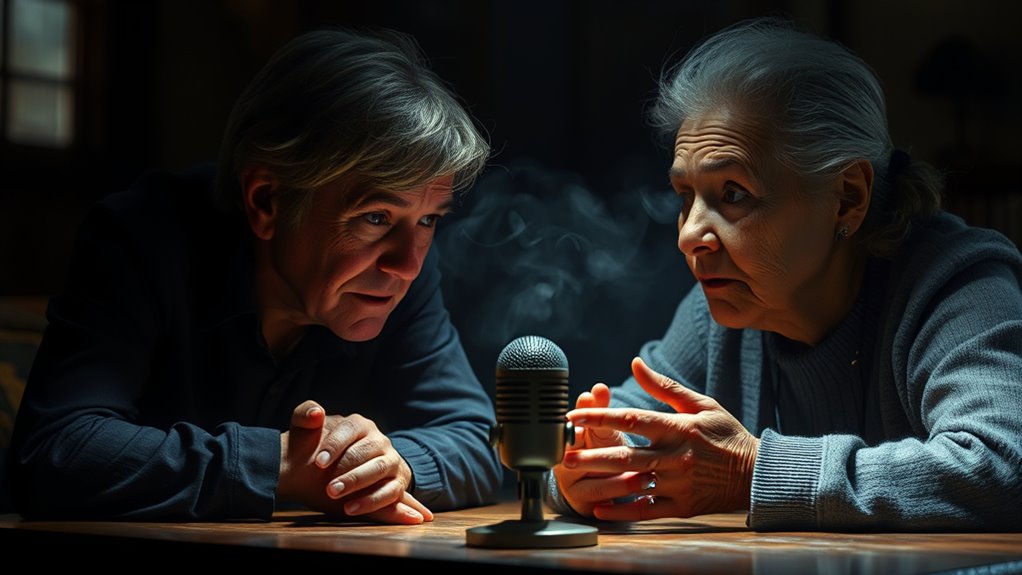
As you listen to eyewitness stories, pay close attention to facial expressions, body language, and tone of voice. These non-verbal cues can reveal feelings or truths that words might miss. By observing these signals, you gain a deeper understanding of their experiences and emotions.
Notice Facial Expressions
When listening to eyewitness accounts of ghosts, paying close attention to facial expressions can reveal essential non-verbal cues that words might overlook. Facial expressions offer immediate insights into a witness’s emotional state, highlighting feelings they may not openly share. Notice subtle changes like widened eyes, furrowed brows, or tight lips, which serve as emotional cues indicating fear, confusion, or disbelief. These cues can help you understand their experience more deeply and differentiate genuine encounters from possible exaggerations. By focusing on facial expressions, you gain a clearer picture of their emotional response, which enriches your understanding of the account. Remember, non-verbal signals often speak louder than words, providing significant context in ghost eyewitness interviews.
Observe Body Language
To truly understand eyewitness accounts of ghosts, you need to actively observe body language and listen carefully to non-verbal cues. Pay close attention to facial expressions, as they can reveal fear, confusion, or disbelief. Notice body posture—tight, tense positions might indicate distress, while a relaxed stance could suggest calm or uncertainty. Watch for subtle movements like shifting or fidgeting, which may signal discomfort or anxiety. Keeping your eyes on these cues helps you interpret what the witness might be hesitant to verbalize. By observing these non-verbal signals, you gain a deeper understanding of their experience, allowing you to ask more targeted questions and build trust. This attentive approach ensures you gather thorough, accurate accounts of their ghost encounter.
Listen for Tone
Listening carefully to a witness’s tone of voice reveals much about their true feelings and level of belief. A consistent tone often indicates sincerity, while shifts or hesitation might suggest doubt or emotional distress. Pay attention to tone consistency—does their voice sound steady, or does it fluctuate when describing certain details? Emotional sensitivity also plays a role; a trembling voice, nervousness, or heightened pitch can signal strong emotions or unresolved fears. By actively listening, you can detect underlying feelings that words alone may not express. This insight helps you gauge their credibility and emotional state, making your interview more effective. Remember, tone can reveal whether a witness is genuinely distressed or simply recounting an experience. Observing these cues deepens your understanding of their account.
Handling Sensitive or Distressing Information
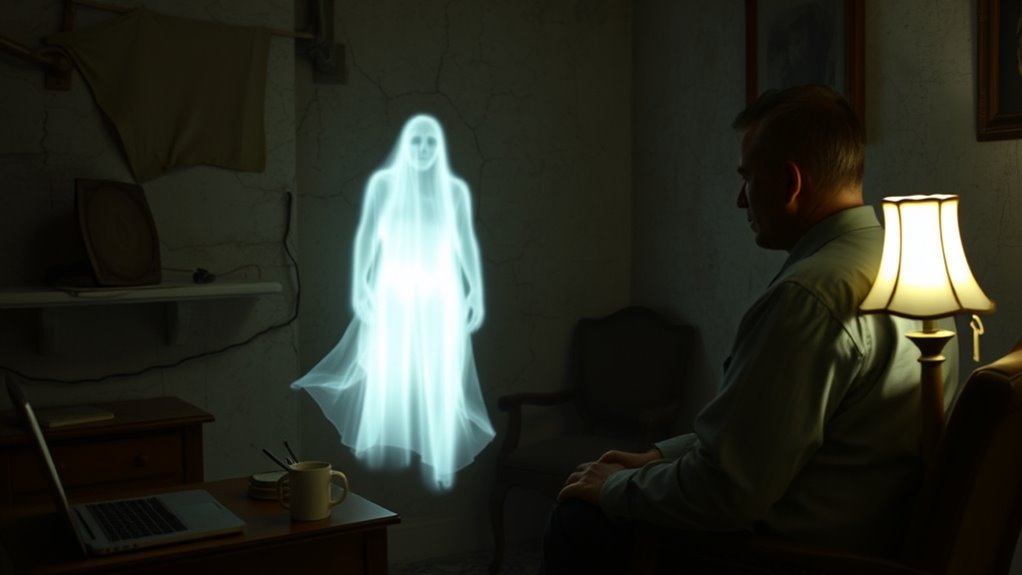
Handling sensitive or distressing information requires careful attention, especially when dealing with eyewitness accounts of ghosts that may evoke strong emotions or fear. Your role involves maintaining emotional resilience and adhering to ethical considerations to protect the witness’s well-being. Be attentive to their reactions, offering reassurance and support. Use the table below to navigate the emotional landscape:
| Emotional Response | Appropriate Response |
|---|---|
| Fear or Anxiety | Offer comfort and validate feelings |
| Confusion or Doubt | Clarify gently, avoid judgment |
| Trauma or Distress | Pause the interview if needed |
| Resistance | Respect boundaries, don’t push |
| Relief | Celebrate their courage |
This approach ensures you handle information ethically while respecting the witness’s emotional state.
Documenting the Witness’s Account Accurately
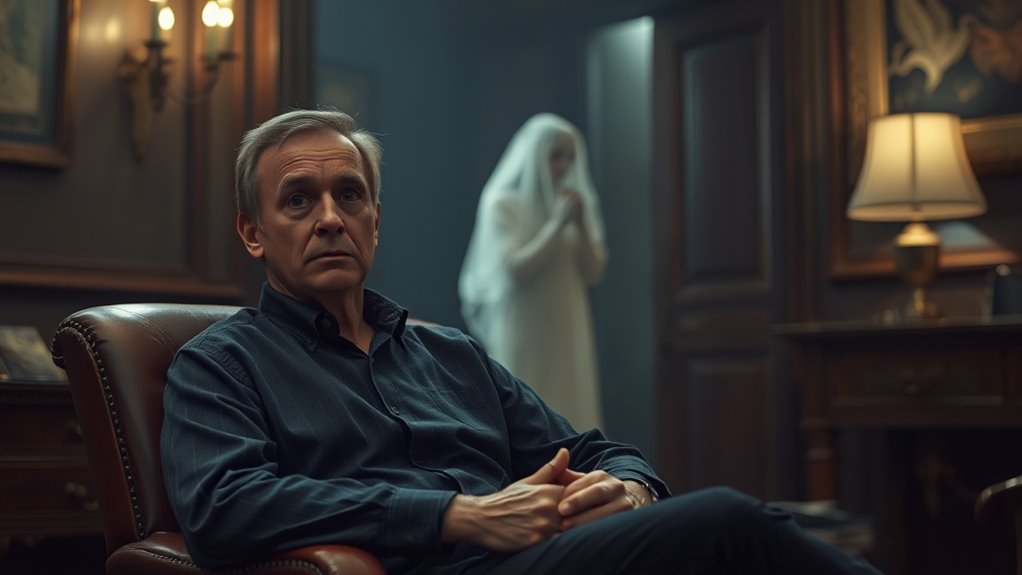
When documenting a witness’s account, you need to clarify their details clearly to guarantee accuracy. Pay close attention to descriptive language, capturing specific sights, sounds, and feelings they share. Doing so helps preserve the authenticity of their experience and builds credibility in your report.
Clarify Witness Details
To guarantee an eyewitness account is accurately documented, you need to capture specific details about the witness’s perspective and experience. Begin by verifying their identity to ascertain you’re speaking with the right person, which adds credibility to their account. Next, clarify the location where the sighting occurred, asking for precise details like room, building, or outdoor area. This helps you understand the context and cross-reference other reports. Be specific about the time of the encounter and any surrounding conditions, such as lighting or weather. Confirm these details gently but firmly, avoiding assumptions. Accurate documentation of these elements ensures a clear, reliable record, making it easier to analyze the account later and establish its credibility.
Record Descriptive Language
Capturing the vivid details of a witness’s description is essential for creating an accurate record of their experience. Focus on sensory details that paint a clear picture, such as sounds, smells, textures, and sensations they recall. Use descriptive imagery to convey the ghost’s appearance, movement, or environment, helping readers visualize the scene. Encourage the witness to describe specific details, like the color of a glow or the feel of a cold breeze. Be precise and objective, avoiding interpretation or assumptions. Document their words exactly as they express them, capturing nuances that reveal their emotional state. This detailed, sensory-rich account becomes a crucial piece of evidence, offering future researchers a genuine glimpse into their encounter.
Analyzing and Interpreting the Testimony

Analyzing and interpreting ghost testimony requires careful consideration of both the details provided and the context in which they are given. You need to evaluate how memory recall might influence the witness’s account, recognizing that memories can be influenced by time, emotion, or suggestion. Cultural influences also play a significant role; beliefs and traditions shape how witnesses perceive and describe their experiences. Be aware that cultural background can affect the language used and the interpretation of paranormal phenomena. When analyzing testimony, look beyond surface details and consider these factors to understand the underlying meaning or possible biases. This approach helps guarantee your interpretation is balanced, objective, and sensitive to the witness’s perspective.
Frequently Asked Questions
How Can I Verify the Accuracy of a Ghost Witness’s Account?
To verify the accuracy of a ghost witness’s account, focus on evidence validation and testimony consistency. Ask clear, specific questions to see if their story remains consistent over time. Cross-reference their details with physical evidence or other witnesses’ accounts. Trust your intuition and look for corroborating details. Remember, consistency and corroboration are key to evaluating the credibility of their testimony and distinguishing genuine experiences from possible fabrications or misinterpretations.
What Legal Considerations Exist When Documenting Paranormal Testimonies?
When documenting paranormal testimonies, you need to consider legal rights and privacy concerns. Make sure you have the witness’s consent before recording or sharing their story, respecting their privacy. Be aware of laws related to recording conversations and maintaining confidentiality. Protect their identity if they request anonymity, and avoid making false claims that could lead to legal issues. By respecting these legal considerations, you safeguard both the witness and yourself.
How Do Cultural Beliefs Influence Ghost Witness Testimonies?
You should recognize that cultural beliefs and narratives heavily influence ghost witness testimonies. Your belief systems shape how witnesses interpret their experiences, often filtering encounters through cultural lenses. These cultural narratives can lead witnesses to describe phenomena in ways that align with their community’s stories, affecting the credibility and interpretation of their accounts. Being aware of these influences helps you better understand and contextualize the testimonies you gather.
What Are Common Psychological Effects on Ghost Witnesses?
You might think ghost sightings are just spooky stories, but they often come with real psychological effects. Trauma responses can cause intense fear or guilt, while memory distortion tricks you into recalling events differently. Ironically, witnessing a ghost can make you question your sanity, leading to anxiety or paranoia. These effects show that even in the supernatural domain, the mind’s reactions are powerful, shaping what you believe you saw.
How Should I Handle Conflicting Accounts From Multiple Witnesses?
When handling conflicting narratives from multiple witnesses, you should carefully evaluate each person’s account to assess their credibility. Stay neutral, listen actively, and avoid bias. Ask clarifying questions to understand discrepancies. Remember, conflicting accounts are common, so look for patterns or commonalities. This approach helps you piece together the most accurate story, respecting each witness’s perspective while maintaining a balanced view of the overall evidence.
Conclusion
When interviewing a ghost witness, your goal is to gather clear, honest accounts. Did you know that 65% of witnesses feel more comfortable sharing their stories when they’re in a relaxed setting? By establishing trust and actively listening, you can uncover valuable details that might otherwise stay hidden. Remember, your careful approach not only respects their experience but also helps you piece together the mystery behind their encounter with the supernatural.
